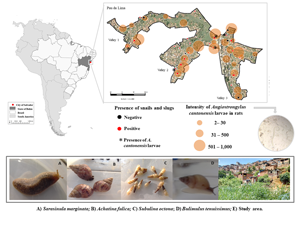Crossref Citations
This article has been cited by the following publications. This list is generated based on data provided by
Crossref.
Silva, G. M.
Thiengo, S. C.
Sierpe Jeraldo, V. L.
Rego, M. I. F.
Silva, A. B. P.
Rodrigues, P. S.
and
Gomes, S. R.
2022.
The invasive giant African land snail,Achatina fulica(Gastropoda: Pulmonata): global geographical distribution of this species as host of nematodes of medical and veterinary importance.
Journal of Helminthology,
Vol. 96,
Issue. ,
Souza, Felipe Correa Rezende de
Melo, Leyva Cecília Vieira de
Kanamura, Cristina
Mota, Dan Jessé Gonçalves da
Chiodelli, Silvia Gabriel
and
Silva Pinto, Pedro Luiz
2022.
Detecção de antígenos em cortes parafinados de vermes e caramujos infectados por Angiostrongylus cantonensis pela reação de imunofluorescência.
Revista do Instituto Adolfo Lutz,
Vol. 81,
Issue. ,
p.
1.
Grandón-Ojeda, Alexandra
Moreno, Lucila
Garcés-Tapia, Carolina
Figueroa-Sandoval, Fernanda
Beltrán-Venegas, Jazmín
Serrano-Reyes, Josselyn
Bustamante-Garrido, Bárbara
Lobos-Chávez, Felipe
Espinoza-Rojas, Hellen
Silva-de la Fuente, María Carolina
Henríquez, AnaLía
and
Landaeta-Aqueveque, Carlos
2022.
Patterns of Gastrointestinal Helminth Infections in Rattus rattus, Rattus norvegicus, and Mus musculus in Chile.
Frontiers in Veterinary Science,
Vol. 9,
Issue. ,
Souza, Felipe Correa Rezende de
Melo , Leyva Cecília Vieira de
Kanamura , Cristina
Mota , Dan Jessé Gonçalves da
Chiodelli , Silvia Gabriel
and
Silva Pinto, Pedro Luiz
2022.
Detecção de antígenos em cortes parafinados de vermes e caramujos infectados por Angiostrongylus cantonensis pela reação de imunofluorescência .
Revista do Instituto Adolfo Lutz,
Vol. 81,
Issue. ,
p.
1.
De Pauli-Yamada, Laís Fernanda
and
Silva Pinto, Pedro Luiz
2023.
Caracterização morfológica e morfométrica de estágios larvares de Strongyloides spp., ancilostomídeos e Angiostrongylus spp.: subsídios para identificação em amostras ambientais.
Revista do Instituto Adolfo Lutz,
Vol. 82,
Issue. ,
p.
1.
Jaume-Ramis, Sebastià
Martínez-Ortí, Alberto
Delgado-Serra, Sofía
Bargues, María Dolores
Mas-Coma, Santiago
Foronda, Pilar
and
Paredes-Esquivel, Claudia
2023.
Potential intermediate hosts of Angiostrongylus cantonensis in the European Mediterranean region (Mallorca, Spain).
One Health,
Vol. 17,
Issue. ,
p.
100610.
De Pauli-Yamada, Laís Fernanda
and
Silva Pinto, Pedro Luiz
2023.
Caracterização morfológica e morfométrica de estágios larvares de Strongyloides spp., ancilostomídeos e Angiostrongylus spp.: subsídios para identificação em amostras ambientais.
Revista do Instituto Adolfo Lutz,
Vol. 82,
Issue. ,
p.
1.
Cowie, Robert H.
Malik, Richard
and
Morgan, Eric R.
2023.
Vol. 121,
Issue. ,
p.
65.
Low, Suey Yee
Lau, Seng Fong
Ahmad, Nur Indah
Sharma, Reuben Sunil Kumar
Rosli, Muhammad Zahin
Mohd‐Taib, Farah Shafawati
Ajat, Mohd Mokrish Md.
Kamaludeen, Juriah
Syed Hussain, Sharifah Salmah
Wan, Kiew‐Lian
Salleh, Annas
and
Aziz, Nor Azlina Abdul
2023.
A cross‐sectional study ofAngiostrongylus malaysiensisin rats and gastropod hosts from recreational parks in Kuala Lumpur, Malaysia: Detection, risk factors and pathology.
Zoonoses and Public Health,
Vol. 70,
Issue. 7,
p.
636.
Hancke, Diego
Guzman, Noelia
Tripodi, Mariel
Muschetto, Emiliano
and
Suárez, Olga Virginia
2024.
Reaching new lands: Updating the distribution of Angiostrongylus cantonensis in South America with the first record in Argentina.
Zoonoses and Public Health,
Vol. 71,
Issue. 6,
p.
748.
